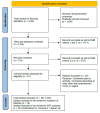Genital Microbiota and Outcome of Assisted Reproductive Treatment-A Systematic Review
- PMID: 36431002
- PMCID: PMC9693990
- DOI: 10.3390/life12111867
Genital Microbiota and Outcome of Assisted Reproductive Treatment-A Systematic Review
Abstract
The balance between different bacterial species is essential for optimal vaginal health. Microbiome includes the host genome along with microorganism genomes and incorporates the biotic and abiotic factors, reflecting the habitat as a whole. A significant difference exists in the composition and number of the human microbiota in healthy individuals. About one-tenth of the total body microbiota exists in the urogenital tract and these can be identified by microscopy and culture-based methods, quantitative PCR, next generation and whole genome sequencing. The trend of delaying the planning of pregnancy to a later age nowadays has resulted in magnifying the use of assisted reproductive treatment (ART). Hence, genital microbiota and its impact on fertility has generated immense interest in recent years. In this systematic review, we searched the available evidence on the microbiota of the genital tract in women undergoing ART and studied the outcomes of IVF in different microbial compositions. Despite the inconsistency of the studies, it is evident that vaginal, cervical and endometrial microbiota might play a role in predicting ART outcomes. However, there is no clear evidence yet on whether the diversity, richness, quantity, or composition of species in the maternal genital tract significantly affects the outcomes in ARTs.
Keywords: assisted reproductive treatment; in vitro fertilization; infertility; microbiota; outcome.
Conflict of interest statement
The authors declare no conflict of interest.
Figures
References
Publication types
LinkOut - more resources
Full Text Sources


